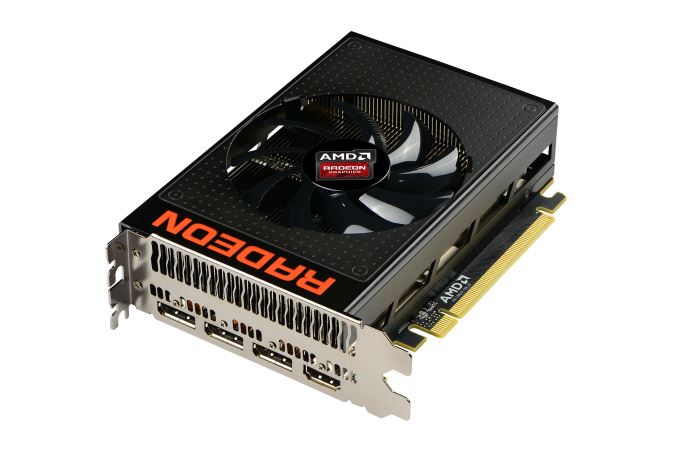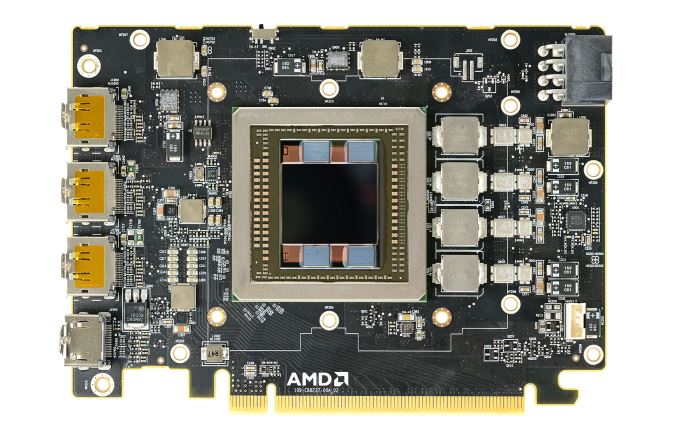The AMD Radeon R9 Nano Review: The Power of Size
by Ryan Smith on September 10, 2015 8:00 AM ESTFinal Words
Of all of the Fiji-based cards we’ve looked at so far, I feel like the Radeon R9 Nano is the most interesting of them. It’s not the fastest card or the cheapest card, but I like that AMD is trying unconventional things. A product like the R9 Nano will never be a high volume product, but it’s the kind of outside the box thinking AMD needs to do in order to better differentiate themselves from NVIDIA and to escape their increasingly damaging reputation as the value alternative underdog.
To that end there’s a lot to like about the R9 Nano, though it admittedly defies standard categorization at times. By all practical metrics this is a luxury card in the same vein as NVIDIA’s GTX Titan series, but at the same time it’s not a card built for chart-topping performance. Rather it’s a card built to push the envelope on power and space efficiency. This makes AMD’s job to sell the card to the public both harder and easier, though not always for obvious reasons.
Starting with the highlights then, let’s talk about the size. As far as Mini-ITX cards go the R9 Nano is a card without an equal. It is the fastest Mini-ITX card on the market and comfortably so, thanks to the fact that all other cards in this space are based on lower performing parts such as the GeForce GTX 970 and Radeon R9 380. Producing a small card is a solid, practical application of the Fiji package and the space savings of HBM, allowing AMD to produce a card just 6 inches (152mm) long. If you need the fastest thing that fits into 170mm or less – and you don’t mind paying top dollar for it – then the R9 Nano has earned its place right there.
Meanwhile when it comes to energy efficiency, the R9 Nano also marks a new high point for AMD. To cut right to the chase, AMD has struggled on the subject of energy efficiency for some time now, particularly since NVIDIA launched their Maxwell 1 and Maxwell 2 architectures last year. The release of the R9 Nano represents a significant improvement for AMD, showing us what an energy efficient implementation of Fiji is capable of.
Relative to the other Fiji cards – the Radeon R9 Fury series – AMD has been able to significantly cut their power consumption in exchange for a limited performance regression. At 2560x1440 – what I expect will be the gaming sweet spot for the R9 Nano – the card delivers 90% of the R9 Fury X’s performance and 96% of the R9 Fury’s performance. Though a tangible decrease in performance, it comes with 35% and 20% decrease in power consumption respectively, allowing AMD to offer better performance-per-watt than any other Radeon product to date.
Now there is a catch here, and that these efficiency improvements come from chip binning and a careful crafting of the product specifications, and not from an architectural improvement. On the whole Fiji still needs to draw quite a bit of power to achieve its peak performance and R9 Nano doesn’t change this. Instead with R9 Nano AMD makes a deliberate and smart trade-off to back off on GPU clockspeeds to save significant amounts of power. The last 100MHz of any chip is going to be the most expensive from a power standpoint, and as we’ve seen this is clearly the case for Fiji as well.
Otherwise on a broader competitive basis, while AMD is enjoying an improvement in energy efficiency they still must contend with NVIDIA, and here is where things get murky. Relative to the rest of their lineup the R9 Nano’s energy efficiency is fantastic. However relative to the energy efficiency of NVIDIA’s lineup, AMD’s gains mostly serve to close the gap that already existed. While admittedly only painting the broadest of strokes here, R9 Nano demonstrates slightly better performance than GTX 980 –around 5% at 2560x1440 – for a similar increase in power consumption. Which is to say that AMD has closed the gap, but they don’t have any real lead.
As a result the answer to the question “is there a market for energy efficient cards within the desktop space?” is going to hinge on price, and that puts AMD in a rough spot given the R9 Nano’s status as a luxury card. Clearly there’s a market for such cards – NVIDIA has spent the last year doing just that – but price is clearly a factor as well. Luxury products typically offer something that no other product offers, and while AMD’s energy efficiency has improved here, they aren’t offering a level of efficiency NVIDIA wasn’t already offering. And that as a result makes AMD’s task all the harder; they can’t pitch energy efficiency as a luxury element if NVIDIA already offers it.
In the end then the R9 Nano is a mixed bag for potential buyers. Its $650 price tag is without a doubt steep compared to the R9 Fury X and GTX 980 Ti, but in its niche of Mini-ITX cards it’s the card to beat, and that will give AMD the room they need to charge that price. On the other hand as great as R9 Nano’s power consumption and energy efficiency are, unless you also need the small size it doesn’t do enough to set itself apart from cheaper products like the GTX 980.
Finally, turning our eyes towards the future, there is one final Fiji product launch on AMD’s 2015 roadmap, and that is the unnamed dual Fiji card. By launching the R9 Nano first, AMD has primed the pump to potentially take their dual-GPU card in one of two different directions. They could essentially combine a pair of R9 Fury Xs and go for a maximum power, maximum performance card similar to the Radeon R9 295X2. On the other hand if they were to combine a pair of R9 Nanos they could produce a slightly slower but much more power efficient card. Both configurations have their virtues and weaknesses – energy efficiency versus absolute performance – so it should be interesting to see which of these two routes AMD takes later this year.












284 Comments
View All Comments
anubis44 - Thursday, October 8, 2015 - link
"you forgot to include evidence of them lying, or a reason for why they would lie."Are you for real? Evidence of misrepresentation is that the box says '4GB', and you can only practically use 3.5GB of the 4GB in a game, or the performance will tank. How much more evidence do you require?
As for a reason why they would do this? You've got to be joking. $$! That's why. The memory controller they used to make a '4GB' card was cheaper than one that would have run all the memory at full speed. That would likely have pushed the price of the card well above $400, and outside of the targeted dupe market of $350-$400. The cheaper, gimped memory controller also meant that nVidia made more profit per card. They just hoped nobody would catch their use of a gimped memory controller before they'd ripped off tens of thousands of slavishly loyal nVidiots who all mindlessly rushed out to computer stores to plunk down their money. And it worked. Tens of thousands have plunked down their money, and nVidia has posted better than ever earnings. What a surprise.
anubis44 - Thursday, October 8, 2015 - link
HA HA HA! An 'honest' mistake? Give me a break! Are you saying nVidia just didn't realize that the cheap memory controller they saddled the GTX970 had a flaw? Yeah, right. They just didn't know that the last .5GB of memory would be gimped by running it at 1/7 the speed of the other 3.5GB. And of course, the decision to use that cheaper memory controller didn't have ANYTHING to do with padding their already fat profit margins at the expense of their customers. Meanwhile, they have the audacity to print '4GB Ram' on all the boxes. As if nVidia just didn't realize that tens of thousands of nVidiots wouldn't go out and buy the cards for a few months before an independent reviewer finally caught them in the act. nVidia is as guilty as a cat in a goldfish bowl, and if you're going to pretend that this whole fiasco was 'handled admirably' by nVidia, then you must really be a fan of Jen Hsun. Seriously, at least have the self-respect to call a spade a spade and admit that nVidia tried to pull a fast one just to line their pockets and got caught.SolMiester - Thursday, September 10, 2015 - link
Oh please, its already been stated that you have to load up beyond normal use before the .5Gb ram comes into play and for the majority or users at 1080, its doesnt effect them.RussianSensation - Thursday, September 10, 2015 - link
@SolMeiser, 1080P is fine but some gamers who purchased GTX970 did so for their 2560x1440/1600 monitors, in addition to others who bought GTX970 SLI. Also, even if in the majority of games the 3.5GB RAM isn't an issue, it's how NV responded to the situation is what's telling.Kutark - Thursday, September 10, 2015 - link
So, what do you have to say about all the dubious shit AMD said during the pre fiji release? They claimed several times it was the fastest card in the world, when it wasn't, and they KNEW it wasn't.I'm tired of people being inconsistent, if you're going to point out questionable behavior in one company then you have to do it for the other.
silverblue - Friday, September 11, 2015 - link
They could've run benchmarks well before the launch, and then fallen behind once NVIDIA had brought out new drivers, or they could've straight out lied. What I'd like to see is AMD's 4K Gaming Performance Benchmarks bar chart scrutinised for every game to see how far out of reality the results were with the setups that were used, then we can be 100% sure (after all, Fiji is more competitive at 4K than lower resolutions).fuicharles - Friday, September 11, 2015 - link
Not giving a review copies to certain reviewer is worse or the one who create gameworks is worse ?Horza - Thursday, September 10, 2015 - link
Thank you for being the impartial voice of reason Wreckage. I've always enjoyed your measured and balanced approach to assessing the merits of the two big dGPU players. Your attack on Anandtech's credibility holds so much more weight coming from a person with a track record of non-partisan, unbiased viewpoints such as yourself. Thank you again.ingwe - Thursday, September 10, 2015 - link
If you read the final words, I think this is a very fair review. To me it says: "This is better than usual form AMD, but it isn't enough and it is too expensive." Seems accurate and unbiased.bill.rookard - Thursday, September 10, 2015 - link
Actually, I do find it 'enough', it -is- a very good, supremely capable card that comes in at 2/3 of the size with 90% of the performance. Heck, it's faster than the GTX 980. My problem? It is too expensive. I know that prime Fiji chips are in short supply at the moment, but it needs to be about $200 cheaper.If they can get their supply running smoothly and get their yields of the full-fat Fiji up, drop the price to about GTX 980 levels they'd never be able to keep them in stock.